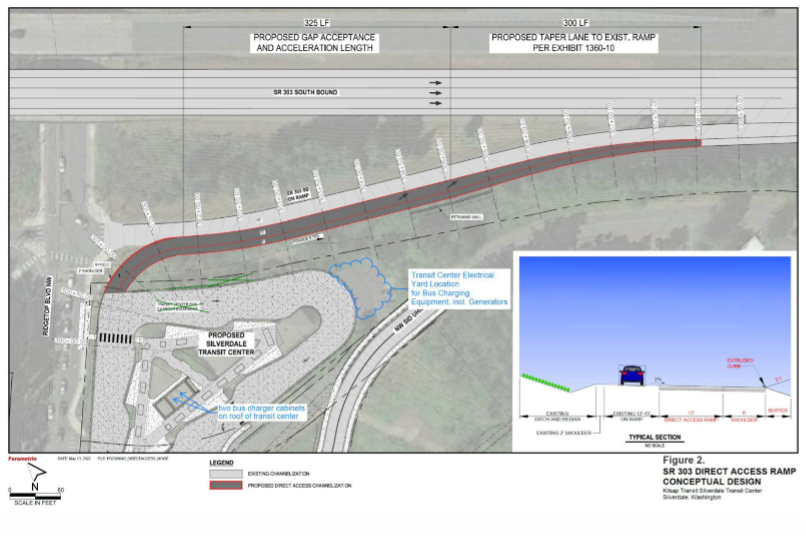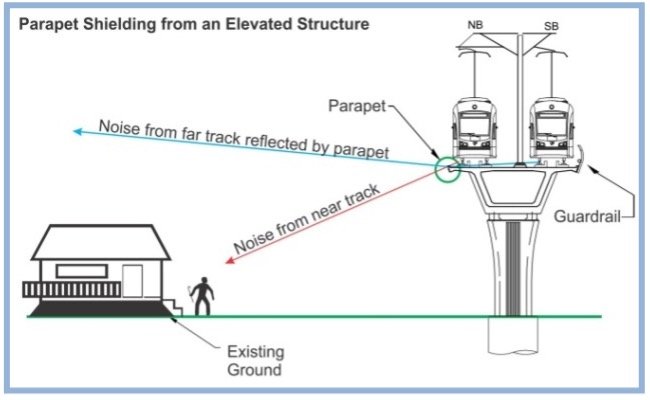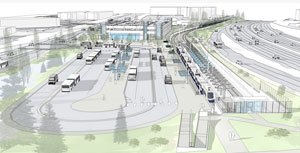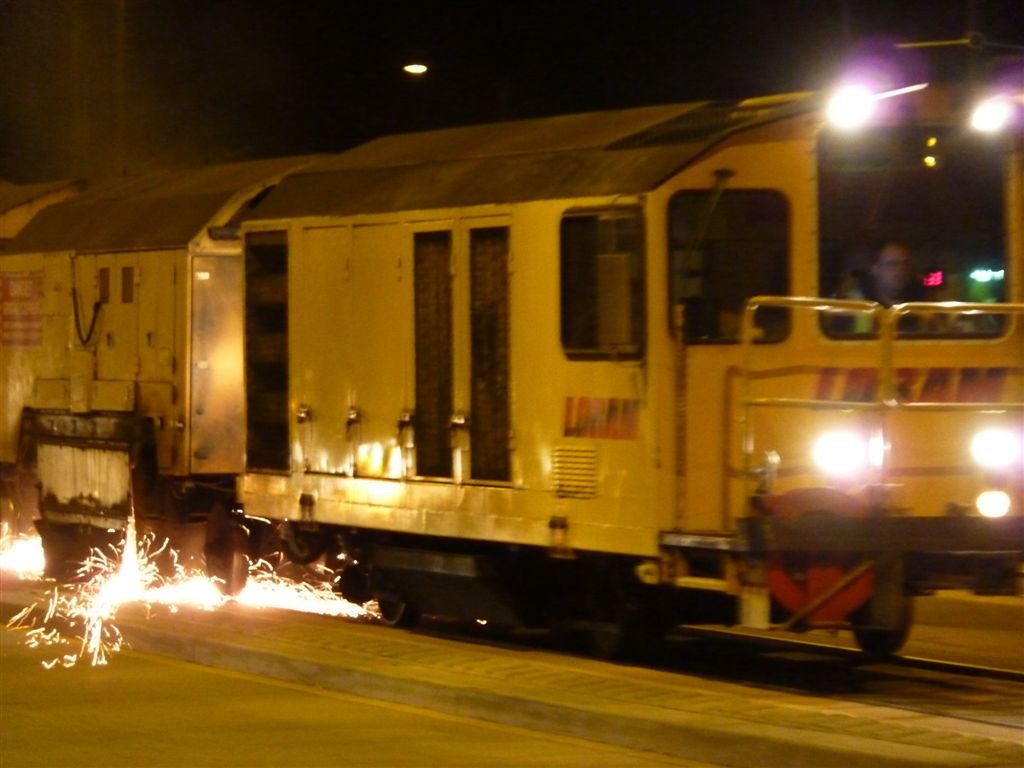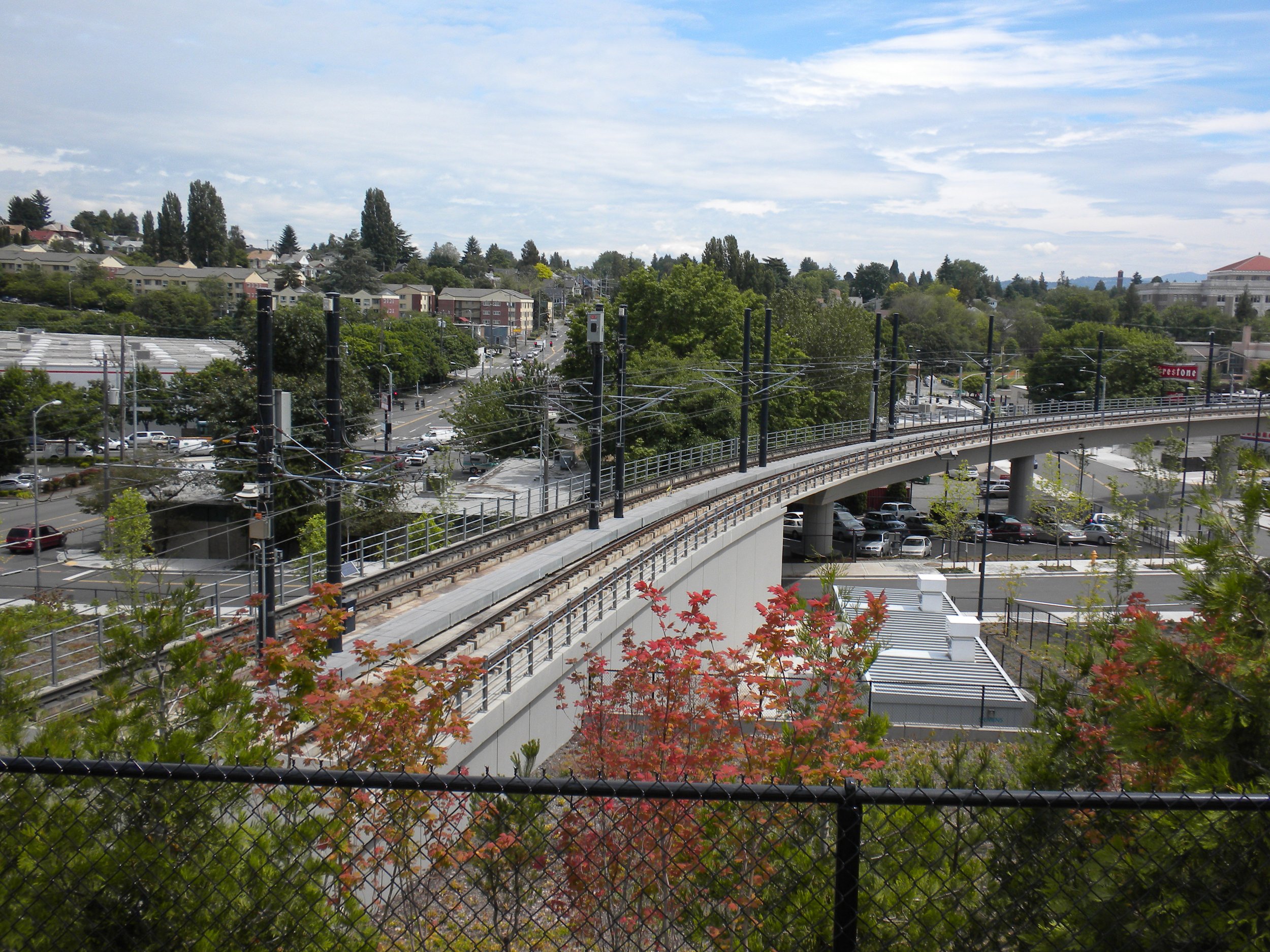
Transit
Silverdale Transit Center Re-Evaluation
Transit Center Re-Evaluation in Silverdale, Washington
Parametrix, Inc. / Kitsap Transit
Silverdale, Washington
MM&A reevaluated the proposed Silverdale Transit Center, just west of SR 303 in the unincorporated community of Silverdale, Washington in Kitsap County. The original noise analysis, produced in July of 2016, included a detailed noise study for transit operations and modified roadways. Since the completion of the initial study, modifications to the project were proposed, to include a new direct transit access ramp from the transit center to SR 303, the installation of battery electric bus (BEB) charging stations, and the installation of back-up generators. MM&A updated the study to include an analysis of the direct access ramp to SR 303 and other improvements. No impacts were identified.
Federal Way Light Rail Extension
DEIS and FEIS
2010 - 2019
Federal Way Light Rail Extension
DEIS and FEIS
Sound Transit
Seattle, Washington
As part of this project, MM&A assisted with developing the final alternatives that were carried forward to the DEIS; and from the DEIS to the FEIS. The Federal Way Light Rail Extension project will likely require the removal and replacement of physical shielding along I-5. Michael has extensive experience with this type of analysis, which includes a detailed light rail and traffic noise analysis using the methods in the FTA Noise and Vibration Manual. MM&A performed the traffic noise analysis using the FHWA TNM and the Washington State DOT criteria and worked closely with WSDOT to arrive at an acceptable criteria for the project. Michael worked closely with CH2M HILL, HDR, and Sound Transit during the DEIS and FEIS; and attended public meetings in support of the project. Mr. Minor authored the noise technical report, supported the DEIS and FEIS sections, and is continuing to support the project by reviewing modifications to the preferred alternative. Finally, MM&A also performed an additional analysis of several design options during the FEIS phase and is tasked to support the project through completion of the environmental process. The graphic above illustrates a complex modeling of noise from traffic and light rail along the Federal Way corridor.
West Seattle – Ballard Light Rail Extension Project
West Seattle - Ballard Light Rail
Sound Transit
Seattle, Washington
Sound Transit is proposing to expand Link light rail transit service from Downtown Seattle to West Seattle and Ballard. The West Seattle and Ballard Link Extensions (WSBLE) Project is an 11.8-mile corridor in the city of Seattle in King County, Washington, the most densely populated county of the Puget Sound region. The West Seattle Link Extension would be about 4.7 miles and the Ballard Link Extension would be about 7.1 miles and include a new 3.3-mile rail-only tunnel from Chinatown-International District to South Lake Union and Seattle Center/Uptown. MM&A is responsible for the noise analysis for the project, which included noise monitoring at over 40 locations. The study area for the West Seattle Link Extension is based on measured noise levels of the existing fleet of Sound Transit light rail vehicles, operational schedule, and train speeds, and is large enough to capture all potential noise impacts from system operations. This amounts to over 70 analysis locations in the Duwamish Segment, over 450 in Delridge, and nearly 900 in the West Seattle Junction area. The locations analyzed include single and multi-family residences, fire stations, schools, daycares, a recording studio, parks, and other FTA noise-sensitive land uses. With the proposed noise mitigation, including noise walls along elevated structures and sound insulation, all noise impacts were mitigated. MM&A continues work on the final environmental impacts analysis.
South Annex Base Metro Maintenance Base Expansion
Metro South Base Annex
OTAK / King County
Washington
MM&A provided detailed noise and air quality studies for the expansion of the Metro South Base to include an Annex for battery electric buses (BEB). The study was performed using the methods from the FTA and included noise monitoring and modeling along with an analysis of potential noise impacts. The noise study showed no adverse effects from the construction and operation of the facility.
The air study included an analysis for potential air quality impacts that could occur during construction or operation of the new base. During project construction, there is a potential for short-term increases in pollutants and dust similar to what is often associated with the construction of infrastructure projects, including hauling materials, and construction workers driving to the site. However, once construction is completed, these short-term increases will dissipate. The operation of the South Annex Base was not predicted to result in any new air quality impacts. The proposed project will include hybrid-electric and battery electric buses with the South Annex Base converting to an all-battery electric fleet of buses in the future. Once an all-battery electric fleet is in place, emissions related to the operation of the South Annex Base would be produced by trips for workers, visitors, and delivery of supplies and materials, along with bus maintenance and repair facilities. Even with the additional vehicle trips for the South Annex Base operations, the project is well below the threshold for a quantitative analysis of air quality. Because the number of trips associated with the South Annex Base operations is well below the threshold for a quantitative analysis, the project meets the transportation air quality conformity requirements and no operational air quality impacts are predicted and no operational air quality mitigation measures recommended.
Sound Transit SR 522/NE 145th Bus Rapid Transit (BRT) Project
Sound Transit SR 522 / NE 145th BRT
David Evans and Assoc. / Sound Transit
Washington
MMA performed a noise analysis for 786 residences, churches, schools, parks, and other noise-sensitive land uses in the corridor. The objective of the study was to assess potential noise and vibration impacts of the project. The potential noise and vibration impacts from the proposed project were evaluated using the current Federal Transit Administration (FTA) Transit Noise and Vibration Impact Assessment (September 2018) methodology. An important note is that 10 of the 12 new uniquely branded BRT buses would be 100 percent Battery Electric Buses (BEBs), greatly reducing the noise and emissions from BRT operations. Overall, the change in noise levels with the project would be from -1 to +1 decibels (dB), a change that is not discernible to most people and project operations would result in no noise impacts.
Sound Transit Operations and Maintenance Facility
2013 - 2018
Sound Transit Operations and Maintenance Facility in Bellevue, WA
Sound Transit
Bellevue, Washington
Mr. Minor performed the technical noise and vibration analysis for the draft and final environmental impact statement for a proposed Link Light Rail Operations and Maintenance Satellite Facility, with options in Lynnwood and Bellevue, Washington. This analysis included noise from the general maintenance of light rail vehicles, vehicle wash systems, ventilation and cooling system for power substations, and tight radius track causing wheel squeal. Several mitigation measures were recommended based on the location of the new facility. For the Lynnwood location, automatic noise reducing doors for the wash bays and acoustical noise walls to prevent noise from HVAC systems from reaching into the nearby neighborhood. The selected location in Bellevue, shown just following construction here, had fewer noise impacts this some other sites, but still required automatic noise reducing doors for the wash bays, and a noise wall was also considered along the eastern border. Lubrication is used to prevent wheel squeal on all Sound Transit alignments.
S 200th Operational Noise and Vibration Study
2016 - 2019
S 200th Link Light Rail
Sound Transit
Seattle, Washington
Prior to opening for normal operations, and six months after normal revenue service was started, Mr. Minor performed a series of noise, vibration, and rail roughness measurements on the Sea-Tac Airport to S 200th Link light rail alignment. The purpose of the study was to provide operational noise and vibration levels from the new 1.6 mile elevated double track light rail transit between SeaTac Airport and South 200th Street. This analysis provides a detailed review of measured noise and vibration levels associated with the project at key locations along the corridor and compares them to the FTA noise and vibration impact criteria to assure compliance. In addition to the noise and vibration measurements, measurements of the rail roughness and rail decay were also performed. Rail roughness measurements provide a detailed analysis of the condition of the rails and can help to determine if rail grinding is necessary. The measurements of the conditions of the rails were compared to the International Standard ISO 3095. The study results demonstrated that there were no residual noise or vibration impacts at any of the measurement locations and noise levels were in agreement with the predicted noise levels in the final design analysis. The photo is a long exposure of a nighttime pass-by of the link light rail taken from a nearby parking garage used for reference noise level measurements.
Seattle Light Rail Initial Segment On-Call Noise and Vibration Consultant
2009 - 2017
Seattle Light Rail
Sound Transit
Seattle, Washington
MM&A, along with ATS Consulting, was awarded the current on-call noise and vibration contract with Sound Transit. Michael performed post-construction noise and vibration testing of the Initial Segment from downtown Seattle to the Sea-Tac Airport. Work performed under this contract included updated noise and vibration measurements, identifying, and verifying noise impacts, deriving noise and vibration mitigation measures, and drafting a supplemental noise and vibration analysis for several sections of the Link Initial Segment. Michael also performed reference pass-by noise measurements of Sound Transit’s fleet of light rail vehicles that are used on all existing environmental studies. Mr. Minor and ATS also worked with Sound Transit to analyze and reduce noise levels from train mounted and intersection warning systems. Using vibration testing, Mr. Minor identified a section of track where vibration levels exceeded the FTA criteria and worked with Sound Transit and King County to remedy the issue. Mr. Minor and ATS also worked with Sound Transit to solve potential issues with rail corrugation and increased noise levels in the Duwamish River area. Mr. Minor brought in a rail-roughness measurement expert from Europe to assist with the analysis of the trackway. The photo shows rail roughness measurements being performed on the elevated structure near the Duwamish River during nighttime closures.
North Link Light Rail Final Design
2008 - 2013
Jacobs Engineering / Sound Transit
Washington
North Link Light Rail
Michael was the Noise Analyst for the updated North Link Extension from the University of Washington to the Northgate Park and Ride. MM&A measured and analyzed existing noise conditions and predicted potential noise and vibration impacts as part of the environmental study. Michael authored the noise technical report and worked closely with Parametrix and Sound Transit on completion of the environmental analysis. Directly following the FEIS, Michael worked closely with Jacobs Engineering and Sound Transit to perform the final design of noise mitigation for the trackway from the tunnel portal to the Northgate Station. His analysis included allowing access of high rail vehicles through a noise wall, integrating a noise wall with a large, retained wall in the retained cut section. Michael also provided Sound Transit with mitigation options that included a 23-foot sound wall, sound insulation, and worked with the design team to design a detailed noise mitigation plan for this section of the corridor. The final noise mitigation includes an array of noise reducing tools, including noise walls, acoustical absorbent materials, acoustical absorptive walls and ballasted trackway with a cross section shown here.
South Link Sea-Tac Airport to S 200th
Park and Ride Light Rail Final Design
2010- 2013
Huitt Zollars / Sound Transit
Washington
South Link Sea-Tac Airport
Michael was the lead noise analyst for the final noise and vibration mitigation for the South Link light rail extension from the Sea-tac Airport to the new S 200th Street Park and Ride Station. Michael designed several noise walls for noise mitigation between the Airport Station and the new park and ride. He also specified resilient fasteners for vibration mitigation along a segment of the elevated trackway. Michael was required to support and testify in several court challenges related to noise and meet with affected property owners. Michael worked closely with Sound Transit on the final design of the trackway and station configuration. Acoustical noise walls are shown in the photo.
East Link Light Rail EIS: 2008 – 2015
Redmond Link Extension: 2017 – 2018
CH2M HILL / Sound Transit
Parametrix, Inc. / Sound Transit
Redmond, Washington
East Link Light Rail EIS
Michael was the lead noise analyst for the new East Link light rail extension from Seattle to Redmond, Washington. As part of this project, Michael assisted with an early screening of several alternatives: providing estimations on potential impacts and mitigation measures. This information was used to develop the final alternatives that were carried forward to the DEIS. For the DEIS analysis, MM&A analysts measured and analyzed existing noise conditions along the complex corridor. MM&A performed a detailed light rail and traffic noise analysis using the methods in the FTA Noise and Vibration Manual. Traffic noise analyzed using the FHWA TNM and the Washington State DOT criteria. Once the preferred alternative was selected, Michael predicted potential noise impacts, designed noise mitigation measures, and worked with the design team to optimize the noise mitigation. Michael worked closely with CH2M HILL and Sound Transit during the screening process. DEIS and FEIS, and also attended public meetings in support of the project. Michael authored the noise technical report, supported the DEIS and FEIS sections, and has continued to support the project by reviewing modifications to the preferred alternative. The proposed Link station near Microsoft is shown above.
More recently, Mr. Minor completed the updated environmental review for noise for the Downtown Redmond Link Extension. This final analysis prior to the design build, included optimizing and replacement noise wall along SR 520, performing an updated detailed noise analysis for Marymoor Park, and revising the final noise mitigation for the elevated segment in Downtown Redmond.
Tacoma Trestle Track & Signal Project
Environmental Analysis and Construction Monitoring: 2014 - 2017
David Evans & Assoc. / Sound Transit
Tacoma, Washington
Tacoma Trestle Track & Signal Project
Michael was the lead noise and vibration analyst for the Tacoma Trestle Track & Signal Project. The Tacoma Trestle project will replace a single-track wooden trestle within an approximately 0.65-mile section of the Sounder Commuter Rail/Amtrak corridor with a double-track bridge structure, plus related track improvements from Freighthouse Square to East M Street in Tacoma. The purpose of the analysis performed by MM&A was to review and identify noise and vibration impacts using the FTA noise and vibration impact criteria. In addition, Michael also performed detailed noise and vibration measurements for pile driving, drafted a construction noise and vibration specification, and monitored noise and vibration during critical periods of construction. Michael authored the noise technical report, continued to support the project by reviewing measurements taken by the contractor, and provided general support on construction to Sound Transit. The photo of the new structure is from Sound Transit project website.
Lynnwood Link Light Rail Extension
DEIS and FEIS
2010 - 2016
Lynnwood Link Light Rail Extension
Sound Transit
Washington
MM&A performed the detailed noise analysis for the Lynnwood Link light rail extension project. This was the first project to have a direct involvement of the FHWA and a request that Sound Transit analyze and mitigate all traffic noise impacts in the project corridor. After several conversations that included critical information compiled by MM&A, the FHWA authored a special rule for transit projects in existing highway corridors: eliminating the need for the traffic noise in locations with no highway modifications. Mr. Minor authored the noise technical report, supported the DEIS and FEIS sections, and is continuing to support the project by reviewing modifications to the preferred alternative. MM&A supported the project through completion of the environmental process and assisted the Design-Build team with the modifications made since completion of the FEIS. The graphic above shows the advance modeling process for parapet shielding from Sound Transit light rail structures used for this and other light rail noise studies.
Sounder Station Improvement Projects
Sound Transit
Sumner & Puyallup, WA
Parametrix, Inc. / Sound Transit
Sumner and Puyallup, Washington
Mr. Minor performed detailed noise, vibration, and air quality analysis for planned improvements to the Sumner and Puyallup Sounder Commuter Rail Stations. MM&A measured and analyzed existing noise conditions and predicted potential noise and vibration impacts as part of the environmental study. Michael authored the noise technical report and worked closely with Parametrix and Sound Transit on completion of the environmental analysis. Directly following completing this analysis, the FTA notified Sound Transit that an air requirement was required for booth stations. MM&A quickly and efficiently complete both reports in a very short time frame, allowing Sound Transit to proceed with the two projects.
Silverdale Transit Center Project
Kitsap Transit / Silverdale, WA
Parametrix, Inc. / Kitsap Transit
Silverdale, Washington
MM&A performed a noise analysis as part of the Kitsap Transit Silverdale Transit Center (TC) Project proposed for construction by Kitsap Transit. The intent of this analysis is to evaluate the effect, if any, of the proposed project on nearby area noise levels. This new transit center required noise analysis using the FTA methodology along with and FHWA analysis for a new and extended access roadway to and from the transit center site. Existing noise levels were measures and modeling was performed to determine the future noise levels and potential impacts. The proposed operational improvements were not predicted to result in noise impacts at any of the nearby noise-sensitive land uses, and transit operations are predicted to be in compliance with all applicable noise regulations and ordinances.
E-360 Final Design Noise and Vibration Mitigation
Bellevue, Washington
T.Y. Lin / Sound Transit
Bellevue, Washington
This detailed wall design and analysis along the East Link corridor was performed to provide final noise mitigation of impacts at the Bellevue Children’s Academy (BCA). The BCA has two buildings located west of 148th Avenue NE in Bellevue, Washington. The analysis included optimizing a noise barrier along the guideway to reduce noise exposure from light rail operations. As part of this project, Mr. Minor produced detailed cross sections using design files in AutoCAD, like the one shown to the right, to verify all measurements and wall height assumptions.
Lane County Transit District Rapid Transit Corridor
Eugene, Oregon
OTAK / Wannamaker Consulting
Lane Transit District
Eugene, Oregon
Michael was the Task Manager for noise and vibration analysis of the proposed West Eugene Expressway rapid bus transit corridor. Analysis requirements include predicting potential noise impacts due to added bus only transit lanes, and park and rides associated with the transit corridor. This project required detailed on-site noise monitoring, the use of the FHWA Traffic Noise Model for analysis of traffic noise along several major streets in the Eugene area. Due to the complex analysis requirements, the analysis used criteria from the FHWA and FTA for final impact analysis. Mr. Minor recommended noise mitigation that included providing sound insulation to several structures in the corridor. Michael was also responsible for attending public meetings, interfacing with the client, and authoring the noise technical report.
North Link Light Rail EIS and Final Design
Parametrix, Inc. / Jacobs Engineering Sound Transit
Seattle, Washington
Michael was the Noise Analyst for the updated North Link Extension, from the University of Washington to the Northgate Park and Ride. MM&A measured and analyzed existing noise conditions and predicted potential noise and vibration impacts as part of the environmental study. Michael authored the noise technical report and worked closely with Parametrix and Sound Transit on completion of the environmental analysis. Directly following the FEIS, Michael worked closely with Jacobs Engineering and Sound Transit to perform the final design of noise mitigation for the trackway from the tunnel portal to the Northgate Station. His analysis included allowing access of high rail vehicles through a noise wall, integrating a noise wall with a large retained wall in the retained cut section. Michael also provided Sound Transit with mitigation options that included a 23-foot sound wall, sound insulation, and worked with the design team to design a detailed noise mitigation plan for this section of the corridor.
Seattle Light Rail Initial Segment On-Call Noise and Vibration Consultant
Seattle Light Rail Testing
Sound Transit
Seattle, Washington
MM&A, along with ATS Consulting were recently awarded an on-call noise and vibration contract directly with Sound Transit. Michael is performing post-construction noise and vibration testing of the initial segment from downtown Seattle to the Sea-Tac Airport. Testing includes performing noise and vibration measurements, verifying noise impacts and mitigation, and performing a supplemental noise and vibration analysis. Michael performed direct testing of trains to assure they meet contract specifications while working with Sound Transit to reduce noise levels of train-mounted and intersection warning systems. Michael identified a section of track with vibration issues that were due to improper track grinding and is working with Sound Transit to solve potential issues with rail corrugation and increased noise levels.
Sea-Tac Airport to S 200th Park and Ride Light Rail Final Design
Jacobs Engineering / Sound Transit
Seattle, Washington
Michael was the lead noise analyst for the final design noise and vibration mitigation for the Link Light Rail extension from the Sea-tac Airport to the new S 200th Street Park and Ride Station. Michael designed several noise walls for noise mitigation between the Airport Station and the new park and ride. He also specified resilient fasteners for vibration mitigation along a segment of the elevated trackway. Michael was required to support or testify in several court challenges related to noise, meet with affected property owners, and worked closely with Sound Transit on the final design of the trackway and station configuration.
East Link Light Rail EIS
CH2M HILL, Inc. & Sound Transit
Seattle, Washington
Michael is the Noise Analyst for the new East Link Light Rail extension from Seattle to Redmond, Washington. Noise analysts at MM&A measured and analyzed existing noise conditions and predicted potential noise and vibration impacts. Michael worked closely with CH2M Hill and Sound Transit during the screening process, and attended public meetings in support of the project. Michael authored the noise technical report. Michael is currently working with CH2M Hill on a second round of screening for four new alternatives in Bellevue.
East Link Light Rail
Seattle Light Rail Initial Segment
Sound Transit
Seattle, Washington
MM&A, along with ATS Consulting, was recently awarded an on-call noise and vibration contract directly with Sound Transit. Michael is performing post-construction noise and vibration testing of the initial segment from downtown Seattle to the Sea-Tac Airport. Testing includes performing noise and vibration measurements, verifying noise impacts and mitigation, and performing a supplemental noise and vibration analysis. Michael performed direct testing of trains to assure they meet contract specifications while working with Sound Transit to reduce noise levels of train-mounted and intersection warning systems. Michael identified a section of track with vibration issues that were due to improper track grinding and is working with Sound Transit to solve potential issues with rail corrugation and increased noise levels.
Track grinding
Milwaukie Light Rail Extension
Parametrix, Inc. / TriMet
Portland, Oregon
Michael is the Task Manager for noise and vibration analysis of an eight-mile corridor of proposed light rail track. Michael is responsible for noise and vibration analysis and mitigation measures using the FTA Noise and Vibration Manual and criteria. Tasks include analysis of noise and vibration levels, performing an additional vibration propagation test, and providing noise and vibration mitigation measures where required.
Tacoma Light Rail Project
Parametrix, Inc. / Sound Transit
Tacoma, Washington
Michael was the Task Manager for noise and vibration analysis on a five-mile corridor of proposed light rail track. Responsibilities included measuring and analyzing existing noise and vibration conditions, measuring vibration propagation characteristics, and predicting potential noise and vibration impacts. Michael also analyzed potential impacts near proposed transit stations for traffic noise impacts, and analyzed potential impacts due to added bus routes that are part of the project. Michael was responsible for co-authoring the noise and vibration results report and interfacing with the client.
Tacoma - Lakewood Commuter Rail Project
Berger ABAM / Sound Transit
Tacoma, Washington
Michael was the Task Manager for noise and vibration analysis on a fifteen-mile corridor of existing freight train track. Responsibilities included measuring and analyzing existing noise and vibration conditions, measuring vibration propagation characteristics, and predicting potential noise and vibration impacts due to the added use of the corridor for commuter rail traffic. Michael analyzed potential impacts near proposed transit stations for traffic noise impacts and was responsible for writing the noise and vibration results report, interfacing with the client, and attending public meetings.
Seattle - Everett Commuter Rail Project
Sound Transit
Seattle, Washington
Michael was the Task Manager for noise and vibration analysis of commuter rail traffic on a thirty-mile corridor of existing freight train track. Michael was responsible for measuring and analyzing existing noise and vibration conditions, measuring vibration propagation characteristics, and predicting potential noise and vibration impacts due to the added use of the corridor for commuter rail traffic. Michael also analyzed potential impacts near seven proposed transit stations for traffic noise impacts. Michael was responsible for writing the noise and vibration results report, interfacing with the client, and attending public meetings.
Lane County Transit District Rapid Transit Corridor
OTAK / Lane Transit District
Eugene, Oregon
Michael is the Task Manager for noise and vibration analysis of the proposed West Eugene Expressway rapid bus transit corridor. Analysis requirements include predicting potential noise impacts due to added bus-only transit lanes, and park and rides associated with the transit corridor. This project required detailed on-site noise monitoring, the use of the FHWA Traffic Noise Model (TNM version 2.5) construction of detailed traffic noise models, and modeling the traffic noise along several major streets in the Eugene area. Due to the complex analysis requirements, the analysis used criteria from the FHWA and FTA for final impact analysis. Recommended noise mitigation and also provided an analysis of construction noise. Michael was also responsible for attending public meetings, interfacing with the client, and authoring the noise technical report.
Metro Interstate MAX Light Rail Project
Parametrix, Inc. / TriMet
Portland, Oregon
Michael was the Task Manager for noise and vibration final design on a ten-mile corridor of proposed light rail track. Michael was responsible for assisting Metro with final noise and vibration mitigation measures. Tasks included additional analysis of vibration levels and vibration projections inside nearby residential land use. Michael was also responsible for deriving mitigation measures including a residential insulation program (RSIP).
